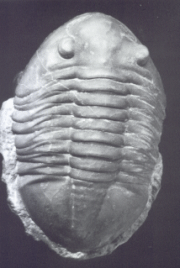The Order
ASAPHIDA (Fortey & Chatterton, 1988)
The Asaphida covers almost 20% of all species of the TRILOBITA and therefore it's featuring various morphologies. The advanced families are associated by an similiar Ontogenesis. The Asaphida are covering the superfamilies Anomocaroidea, Asaphoidea, Dikelokephaloidea, Remopleuridoidea, Cyclopygoidea, Trinucleioidea.
The image shows a representative of the superfamily Asaphoidea (Family Asaphidae).
|
Asaphus expansus (Source: Trilobites, Levi-Setti, 1993)
|
|
Epoch Middle Cambrian to Upper Ordovician. With exception of the representatives of Trinucleioidea, whose cephalon is developed larger than their pygidium, cephalon and pygidium are equal in size. The size of the glabella diversifies from small to huge, depending on the families, glabellar furrows are barely or or even not at all recognizable. The sutures are running ophistoparian. A broad doublure is present. The eyes (predominantly large developed) are present, with exception of the secondary blind species. The freecheeks are typically separated by a median ventralsuture. The primitive species of Asaphida featuring a natant hypostome, in opposite to the higher species, whose are featuring the conterminant or impendent type.
The development is varying and the thorax consits of 2- 30 segments.
Except from some representatives of Trinucleioidea and Remopleuridoidea (smaller pygidium) the pygidium is developed equal in size or even larger than the cephalon.
|
|
